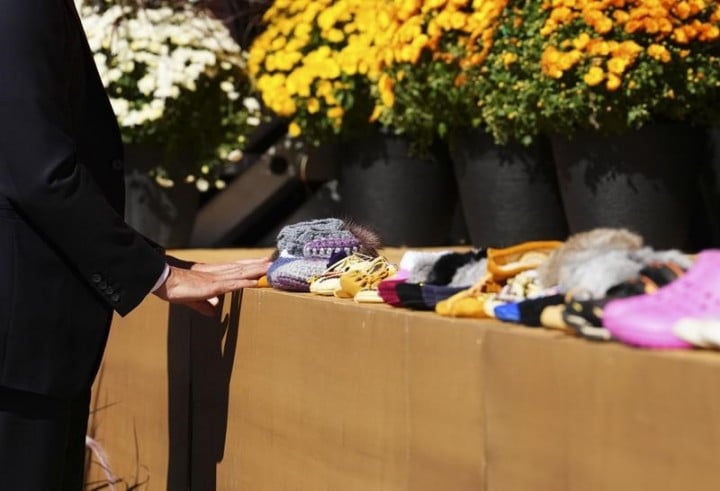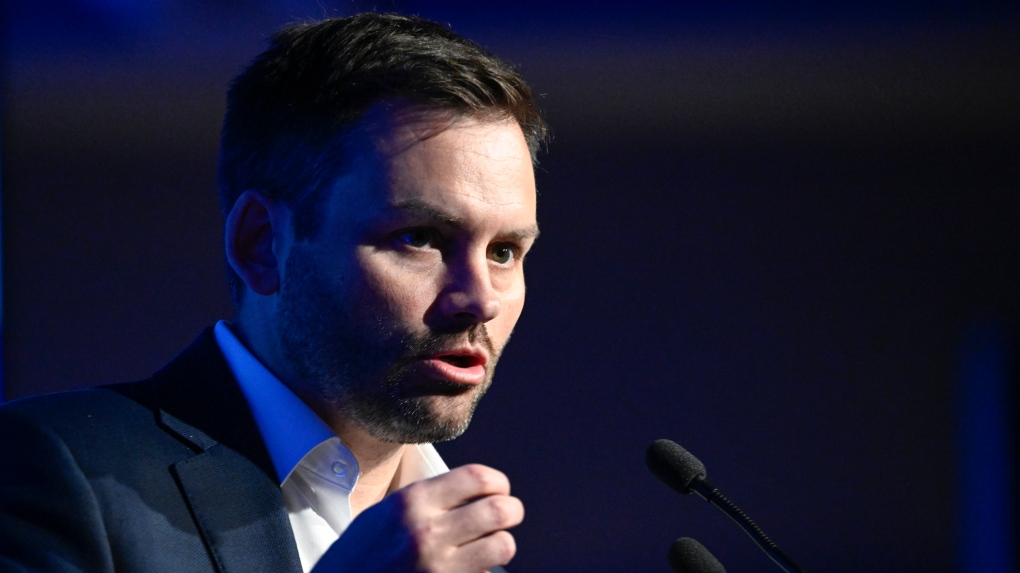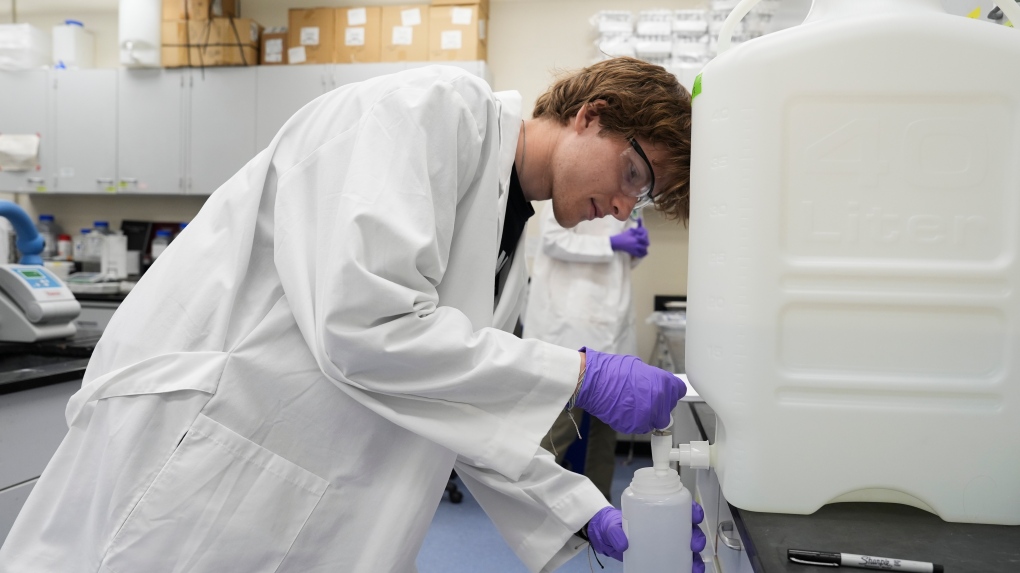News
First Nation works with environmental group to help in residential school searches

|
|
WINNIPEG — A First Nation in Ontario is working with a Winnipeg environmental assessment firm to help communities investigate sites of former residential schools with an Indigenous-led approach.
Missanabie Cree First Nation, through its company ISN Maskwa, is partnering with Narratives Inc. to provide services related to searching unmarked graves and burials, accessing archival records and gathering testimony.
The First Nation says the partnership is a step toward helping communities find the truth of what occurred in residential schools.
“We will be working together to help Indigenous communities investigate, map out and research what happened on residential schools for those who came home and those who did not,” Missanabie councillor Les Nolan said Tuesday.
“This combined effort will assist us all in finding answers to the many questions our people and our families have. It is hoped that by obtaining these answers, the truth will come out and our families get to heal.”
ISN Maskwa is an offshoot of the private security and investigative services firm Investigative Solutions Network. The team has experience investigating homicides, sexual assaults and other violent offences in Indigenous and non-Indigenous communities, said Nolan.
He added many of its investigators are Indigenous, which will help in providing culturally-relevant support.
“Because of the understanding and some lived experiences, our team has the ability to build upon many meaningful relationships in First Nation, Métis and Inuit communities across Canada.”
Chief Jason Gauthier said in a statement that he hopes the partnership encourages other Indigenous-led initiatives to promote healing and work to find answers for communities.
Narratives have been working with several Ontario First Nations in its investigations.
The organization said getting access to records and funding are the biggest challenges.
“We’ve heard time and time again from survivors that they want answers. And the answers are very difficult to find, where we’re just scratching the surface here,” said Somia Sadiq, founder of Narratives.
The federal government plans to spend $320 million to help Indigenous communities heal from the ongoing effects of residential schools through searching former school sites, holding ceremonies or memorializing sites. As of June, Indigenous Services Canada reported 84 funding arrangements.
The first step in investigations is to establish protocols for searches, ceremonies and rituals, said Sadiq. Then communities must decide what records need to be looked at.
Both groups hope by working together that they can educate the broader public and keep conversations about healing for survivors front and centre.
Narratives has already begun working with Wauzhushk Onigum Nation, near Kenora, Ont., in the investigation of the former St. Mary’s Residential School, including using ground-penetrating radar to search the site.
Chief Chris Skead said the work has been challenging and they have relied on guidance from survivors.
Having an Indigenous-led approach to these investigations has been a long time coming, he said.
“We need that expertise, technology (and) that knowledge to come and help and assist communities.”
This report by The Canadian Press was first published Nov. 29, 2022.
Brittany Hobson, The Canadian Press
News
PQ leader unapologetic about comments made regarding Canada – CTV News Montreal


Parti Québécois (PQ) Leader Paul St-Pierre Plamondon isn’t shying away from criticism that comments he made referencing Canada’s colonial past were an inappropriate way to push his party’s sovereignty agenda.
“We need to be considering the whole history of Canada in interpreting what’s happening,” he told CJAD 800’s Aaron Rand.
This comes just days after St-Pierre Plamondon assured that Quebecers “will definitely be living through a third referendum” on sovereignty before the end of the decade if his party is elected.
His reasoning: the federal government poses an “existential threat” to Quebecers.
“What will become of us as Quebecers if we don’t even have a fifth of the votes in a government that decides for us? We’re finished. Canada has a bleak future in store for us,” he told party members at a two-day national council on housing. “It’s a regime that only wants to crush those who refuse to assimilate.”
In speaking with Rand on Wednesday about backlash to his comments, St-Pierre Plamondon pointed out, “I’m not always soft-spoken but I always try to be as thoughtful as possible.”
Nevertheless, he doubled down on his argument, saying the federal government was “disrespecting” the provinces when it comes to issues like immigration.
“That doesn’t give us any hopes of integration, and housing, and of providing services for these people under the federal power of immigration,” he said.
Plamondon stated that there are currently 560,000 temporary immigrants in Quebec, and if the federal government continues on this path, “there is no viable future for Quebec.”
LISTEN ON CJAD 800 RADIO: PQ leader accuses Canada of ‘disrespecting the competencies of provinces’
He also refused to apologize for referencing Canada’s history, saying the country shouldn’t shy away from its past.
“Talking about history is not being radical even though the [Quebec Liberal Party] PLQ or Éric Duhaime tries to distort what I said to make me a radical politician,” he said. “I don’t think people will buy that because I’ve been constant for the past years, and talking about history shouldn’t be radical in my view.”
He points out that his criticisms aren’t specifically aimed at Prime Minister Justin Trudeau or his Liberal Party but at the federal government in general.
“He’s continuing the mission of his father. He has the exact same approach toward Quebec, and that’s fair to do,” St-Pierre Plamondon said. “If we live in a world where the past never happened, it’s difficult to have an appropriate reading of what’s actually happening right now if we have no notion of what happened before.”
He says his beliefs will not change no matter who is in power.
The next federal election is slated to take place on or before Oct. 20, 2025.
News
Drinking water quality: Canada's plan for forever chemicals – CTV News


As the United States sets its first national limits on toxic forever chemicals in drinking water, researchers say Canada is lagging when it comes to regulations.
Still, they acknowledged that Canada is making progress in trying to reduce and prevent the contamination of water in the country.
From carpeting to non-stick cookware, so-called forever chemicals, or perfluoroalkyl and polyfluoroalkyl substances (PFAS), have been widely found in consumer products since the 1950s.
These chemicals are designed to be so strong that they don’t break down fully in the environment. They’re used to make products non-stick, oil- and water-repellent and resistant to temperature change.
Growing evidence shows PFAS are in Canadian freshwater sources and drinking water, according to Health Canada. Studies have linked PFAS to serious health problems, such as cancer, low birth weight and liver disease.
The U.S. Environmental Protection Agency (EPA) finalized its drinking water regulation for six PFAS last week. Under the new regulation, utilities are required to limit certain forever chemicals, including two common types —perfluorooctane sulfonic acid (PFOS) and perfluorooctanoic acid (PFOA) — to four parts per trillion, or four nanograms per litre. As well, water providers must test for these PFAS and alert the public when levels are too high.
Similarly, Health Canada proposed new limits for PFAS in drinking water in February 2023. There are currently drinking water quality guidelines for PFOA and PFOS in Canada.
Under the current guidelines, the limit is 200 ng/L for PFOA, which is 50 times more than the U.S. limit of 4 ng/L. At 600 ng/L for PFOS, the maximum allowable amount in Canada for this type of forever chemical is 150 times more than the U.S limit.
In light of the changes south of the border, CTVNews.ca asked Health Canada whether there were any plans to change the limits, or to follow the American lead on the issue.
In a recent email to CTVNews.ca, Health Canada spokesperson Mark Johnson said the department has proposed a drinking water objective with a much lower limit of 30 ng/L for all PFAS detected in drinking water.
Canada’s strategy
Despite Canada’s proposed drinking water limit for PFAS being about eight times higher than the ones for the United States, many factors are probably at play, according to an expert.
Satinder Kaur Brar, a civil engineering professor and James and Joanne Love Chair in Environmental Engineering at York University in Toronto, has been doing work for the past few decades on various contaminants including PFAS in waters and wastewaters.
“Definitely U.S. EPA has taken a leap forward in this direction,” she said in a video interview with CTVNews.ca, noting no international standards exist. “So I would say that if we have set up higher limits here for the Canadian citizens, definitely we are exposing them more, or making them more vulnerable to these chemicals.”
Canada’s recently proposed limits only deal with drinking water, not other contaminated sources such as food, soils, sediments and air, Brar pointed out. She points to political leaders as being among those to blame for what some may perceive as holes in the proposed policy changes.
“I would say that the political will is also lacking because political will also plays an important role in bringing out these regulations,” she said. “We have left out many important environmental compartments, which are all interlinked and contributing to the overall … presence of PFAS in water.”
‘Stringent enough’?
And when it comes to laws and regulations, a senior environmental law researcher and paralegal says Canada has made strides in tackling the problem, but it’s lagging behind some countries such as the U.S.
“So while the U.S. EPA numbers are set much lower than Canada’s, what we see in Canada is at least a progression from the current guidelines, and that’s not a bad thing,” Fe de Leon, with the Canadian Environmental Law Association in Toronto, said in a video interview with CTVNews.ca.
“The question is whether it’s stringent enough to deal with the scope of impacts that these chemicals have on the environment and particularly human health.”
Health Canada’s Johnson said the final drinking water objective for PFAS will be published later this year, replacing current guidelines. Provinces and territories use these guidelines and objectives to create drinking water quality requirements for all Canadians, he said.
Provincial and territorial authorities have been monitoring treated drinking water in some regions, and the federal government has been monitoring PFAS in freshwater since 2013, Johnson added.
“Current data regarding PFAS in Canadian freshwater sources and drinking water suggest that PFAS are present at levels below the new proposed objective,” Johnson said in an emailed statement. “However, the concentrations of PFAS in freshwater and drinking water may be higher near facilities that use large amounts of these chemicals, locations where firefighting foams containing PFAS were used to put out a fire, and landfills and wastewater treatment plants.”
‘The biggest issue’
A major problem is a lack of information on the forever chemicals affecting Canadians, many of whom may be unaware of what these chemicals are, where they’re found and the impact they can have on our health and the world around us.
“The biggest issue right now is complete disclosure of how many of these chemicals are actually found in the Canadian market and are being released into the environment,” Brar said. “We don’t have a good handle on that.”
Over the last few years, she said, more sites across Canada have been “impacted substantially” by PFAS. “So this is absolutely necessary that the government moves ahead and takes action on these chemicals, and create their own strategy.”
A chemical engineering professor who leads a team that conducts research on the impacts of these chemicals says he believes that both Canada and the U.S. have made their boldest moves so far to address the problem.
“The net effect is that both the U.S. and Canada are trying to limit … these chemicals in drinking water to levels that are extremely low and barely measurable,” said Franco Berruti, director at the Institute for Chemicals and Fuels from Alternative Resources at Western University in London, Ont., in a video interview with CTVNews.ca. “At the end of the day …they will have the similar effect.”
Barriers to a solution
Berruti said there isn’t a simple solution to the problem of controlling the impact of forever chemicals. One of the barriers to regulating them is the many unknowns about PFAS.
“It’s not just a question of two or three chemicals that are considered toxic that one would regulate. But we are talking about thousands and thousands of these chemicals. We don’t even know how to analyze these chemicals,” he said.
The technologies that exist to reduce or eliminate PFAS “are very limited,” Berruti added.
Scientists are still studying different aspects of the problem, including investigating which forever chemicals are more problematic and measurable.
Out of more than 12,000 types of PFAS, Berruti estimates that only 40 may be measurable.
“To set the limits without having the ways of measuring those … extremely low concentrations doesn’t mean anything until the methodologies are there to demonstrate that those limits are reached,” he said.
While Canada doesn’t produce PFAS, Berruti said, the country should closely monitor the imports of products that are contaminated with the chemicals.
Industry concerns
Health advocates praised the U.S. move to create its first drinking water limits on PFAS, but the news wasn’t universally celebrated.
Among the concerns raised were those from water utilities, which said customers will end up paying more for water since treatment systems are expensive to install.
Actions taken in Canada have also been met with challenges and criticism.
In May 2023, Health Canada issued a draft recommendation to label PFAS, an entire class of chemicals, as toxic under the Canadian Environmental Protection Act.
Cassie Barker, the toxics program manager at Environmental Defence, said in March that it was important to label the entire class, not only each individual substance, as toxic, The Canadian Press reported. When Canada designated and banned some types of PFAS in 2012, Barker said, it became a “whack-a-mole” situation, because other products used to replace them also posed health risks.
In response to the proposed PFAS toxic designation, the Chemistry Industry Association of Canada wrote to Environment and Climate Change Canada in June 2023 asking that PFAS not be labelled toxic as an entire class of substances, and instead be designated on a case-by-case basis, based on proven risk.
PFAS currently used by Canadian industry “have not been shown to be of high risk” and sweeping prohibitions could cause economic hardship to the industry, it wrote in its letter.
In the States, growing awareness has led to lawsuits against manufacturers.
For example, 3M settled a series of lawsuits last June that could exceed US$12.5 billion, involving more than 300 U.S. municipalities where the chemicals were found in drinking water. The company said it plans to stop making PFAS by 2025.
In the same month, DuPont de Nemours Inc. and spinoffs Chemours Co. and Corteva Inc. reached a US$1.18-billion deal over similar complaints by about 300 drinking water providers.
And legal action has occurred in Canada as well.
According to the business law firm Osler, a class action was certified in 2021 against the National Research Council of Canada over PFAS in the surface water and groundwater at the NRC’s facility in Mississippi Mills, Ont.
With files from The Associated Press and The Canadian Press
News
CTV National News: Tax hike coming for Canadians? – CTV News
[unable to retrieve full-text content]
CTV National News: Tax hike coming for Canadians? CTV News




Source link
-
Business21 hours ago
Rupture on TC Energy's NGTL gas pipeline sparks wildfire in Alberta – The Globe and Mail
-
News22 hours ago
Loblaws Canada groceries: Shoppers slam store for green onions with roots chopped off — 'I wouldn't buy those' – Yahoo News Canada
-
Investment21 hours ago
Saudi Arabia Highlights Investment Initiatives in Tourism at International Hospitality Investment Forum
-



 Tech14 hours ago
Tech14 hours agoCytiva Showcases Single-Use Mixing System at INTERPHEX 2024 – BioPharm International
-
Art21 hours ago
Squatters at Gordon Ramsay's Pub Have 'Left the Building' After Turning It Into an Art Café – PEOPLE
-



 Politics21 hours ago
Politics21 hours agoThe Earthquake Shaking BC Politics
-



 Science22 hours ago
Science22 hours agoFederal government announces creation of National Space Council – CBC News
-



 Investment20 hours ago
Investment20 hours agoBill Morneau slams Freeland’s budget as a threat to investment, economic growth







